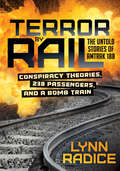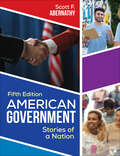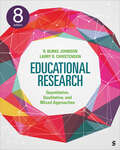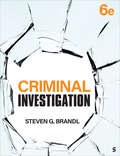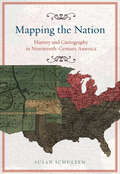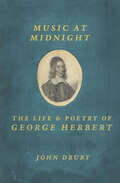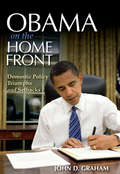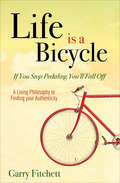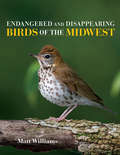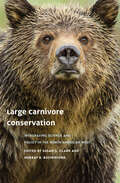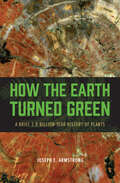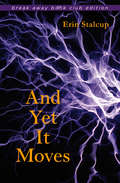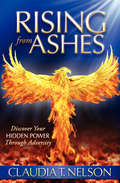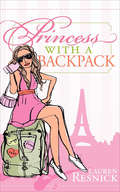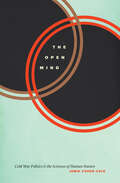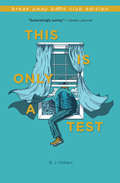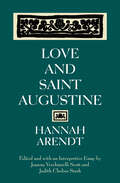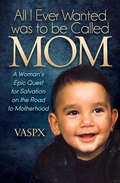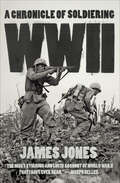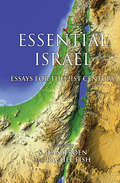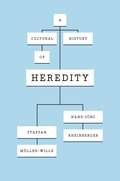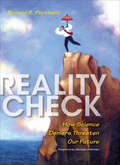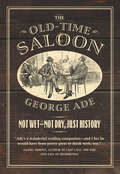- Table View
- List View
Terror by Rail: Conspiracy Theories, 238 Passengers, and a Bomb Train: The Untold Stories of Amtrak 188
by Lynn RadiceA survivor&’s true story of a railway catastrophe that transformed her life—and turned her into a passionate advocate for safety and disaster prevention. Terror by Rail is the compelling true story of a major catastrophic event: the Amtrak 188 accident on May 12, 2015. After the accident, Lynn Radice faced a difficult journey of recovery from trauma—and at the same time, her passion for answers caused her to ask questions about train safety and the bigger global issues that are challenges of the rail. A must read for anyone who travels, lives, or works near a rail system, Terror by Rail is a wakeup call. As the phrase goes, &“See Something Say Something&”—and in this book, the author is doing just that. This story of a single mom&’s heartbreaking journey through hell and back will give everyone facing challenges in their life a bit of hope that nothing is permanent, and it is possible to come through the pain to the other side, and make things better in the process.
American Government: Stories of a Nation
by Scott F. AbernathyAmerican government is not just one story—it’s many stories. Our stories. And they are still being told. In American Government: Stories of a Nation, Scott F. Abernathy tunes into the diverse perspectives and political persuasions involved in American politics. This balanced approach encourages students to actively engage with the material while facilitating a thoughtful exploration of important themes in politics, governance, and current events. Known for addressing issues in a way that is both relatable and solidly grounded in research, the Fifth Edition delivers new ways for students to understand and participate in politics.
Educational Research: Quantitative, Qualitative, and Mixed Approaches
by Robert Burke Johnson Larry B. ChristensenEducational Research: Quantitative, Qualitative, and Mixed Approaches by R. Burke Johnson and Larry Christensen offers a comprehensive, accessible introduction to research methods for undergraduate and graduate students. Readers will develop an understanding of the multiple research methods and strategies used in education and related fields, including how to read and critically evaluate published research and how to write a proposal, construct a questionnaire, and conduct an empirical research study on their own. The Eighth Edition maintains the features that made this book a best-seller, including attention-grabbing chapter-opening vignettes, lively examples that engage student interest, a conversational and friendly writing style, and more. Fully updated for the Seventh Edition of the Publication Manual of the American Psychological Association, this new edition includes expanded information on research ethics and IRBs, expanded and more current information on sampling and causation across research designs, and the latest thinking on mixed methods research. Designed to make learning about research methods enjoyable without sacrificing the necessary rigor, this highly readable text transforms readers into critical consumers and users of research.
Criminal Investigation
by Steven G. BrandlCriminal Investigation, Sixth Edition offers a comprehensive and engaging examination of criminal investigation and the vital role criminal evidence plays in the process. Written in a straightforward manner, the text focuses on the five critical areas essential to understanding criminal investigations: background and contextual issues, criminal evidence, legal procedures, evidence collection procedures, and forensic science. In this brand new edition, author Steven G. Brandl goes beyond a simple how-to on investigative procedures, and draws from fascinating modern research, comprehensive cases, and criminal evidence to demonstrate their importance in the real world of criminal justice, providing students with practical insights into the field of criminal investigation.
American Government: Stories of a Nation
by Scott F. AbernathyAmerican government is not just one story—it’s many stories. Our stories. And they are still being told. In American Government: Stories of a Nation, Scott F. Abernathy tunes into the diverse perspectives and political persuasions involved in American politics. This balanced approach encourages students to actively engage with the material while facilitating a thoughtful exploration of important themes in politics, governance, and current events. Known for addressing issues in a way that is both relatable and solidly grounded in research, the Fifth Edition delivers new ways for students to understand and participate in politics.
Criminal Investigation
by Steven G. BrandlCriminal Investigation, Sixth Edition offers a comprehensive and engaging examination of criminal investigation and the vital role criminal evidence plays in the process. Written in a straightforward manner, the text focuses on the five critical areas essential to understanding criminal investigations: background and contextual issues, criminal evidence, legal procedures, evidence collection procedures, and forensic science. In this brand new edition, author Steven G. Brandl goes beyond a simple how-to on investigative procedures, and draws from fascinating modern research, comprehensive cases, and criminal evidence to demonstrate their importance in the real world of criminal justice, providing students with practical insights into the field of criminal investigation.
Mapping the Nation: History and Cartography in Nineteenth-Century America
by Susan Schulten&“A compelling read&” that reveals how maps became informational tools charting everything from epidemics to slavery (Journal of American History). In the nineteenth century, Americans began to use maps in radically new ways. For the first time, medical men mapped diseases to understand and prevent epidemics, natural scientists mapped climate and rainfall to uncover weather patterns, educators mapped the past to foster national loyalty among students, and Northerners mapped slavery to assess the power of the South. After the Civil War, federal agencies embraced statistical and thematic mapping in order to profile the ethnic, racial, economic, moral, and physical attributes of a reunified nation. By the end of the century, Congress had authorized a national archive of maps, an explicit recognition that old maps were not relics to be discarded but unique records of the nation&’s past. All of these experiments involved the realization that maps were not just illustrations of data, but visual tools that were uniquely equipped to convey complex ideas and information. In Mapping the Nation, Susan Schulten charts how maps of epidemic disease, slavery, census statistics, the environment, and the past demonstrated the analytical potential of cartography, and in the process transformed the very meaning of a map. Today, statistical and thematic maps are so ubiquitous that we take for granted that data will be arranged cartographically. Whether for urban planning, public health, marketing, or political strategy, maps have become everyday tools of social organization, governance, and economics. The world we inhabit—saturated with maps and graphic information—grew out of this sea change in spatial thought and representation in the nineteenth century, when Americans learned to see themselves and their nation in new dimensions.
Music at Midnight: The Life and Poetry of George Herbert
by John DruryThis &“powerfully absorbing&” biography of 17th century Welsh poet George Herbert brings essential personal and social context to his immortal poetry (Financial Times). Though he never published any of his English poems during his lifetime, George Herbert has been celebrated for centuries as one of the greatest religious poets in the language. In this richly perceptive biography, author and theologian John Drury integrates Herbert&’s poems fully into his life, enriching our understanding of both the poet&’s mind and his work. As Drury writes in his preface, Herbert lived &“a quiet life with a crisis in the middle of it.&” Beginning with his early academic success, Drury chronicles the life of a man who abandons the path to a career at court and chooses to devote himself to the restoration of a church in Huntingdonshire and lives out his life as a country parson. Because Herbert&’s work was only published posthumously, it has always been difficult to know when or in what context he wrote his poems. But Drury skillfully places readings of the poems into his narrative, allowing us to appreciate not only Herbert&’s frame of mind while writing, but also the society that produced it. He reveals the occasions of sorrow, happiness, regret, and hope that Herbert captured in his poetry and that led T. S. Eliot to write, &“What we can confidently believe is that every poem . . . is true to the poet&’s experience.&” &“It is hard to imagine a better book for anyone, general reader or seventeenth-century aficionado or teacher or student, newly embarking on Herbert.&”—The Guardian, UK
Obama on the Home Front: Domestic Policy Triumphs and Setbacks (Encounters: Explorations in Folklore and Ethnomusicology)
by John D. Graham&“The best comprehensive review of the Obama administration&’s policies available,&” by the author of Bush on the Home Front (Daniel P. Franklin, author of Pitiful Giants: Presidents in their Final Term). Barack Obama came into office as the economy was careening into the worst downturn since the Great Depression. On the political front, he would be challenged by the same intense congressional polarization faced by Bill Clinton and George W. Bush, now exacerbated by the rise of the Tea Party movement. In this comprehensive assessment of domestic policymaking, John D. Graham considers what we may learn from the Obama presidency about how presidents can best implement their agendas when Congress is evenly divided. What did Obama pledge to do in domestic policy and what did he actually accomplish? Why did some initiatives succeed and others fail? Did Obama&’s policies contribute to the losses experienced by the Democratic Party in 2010 and 2014? In carefully documented case studies of economic policy, health care reform, energy and environmental policy, and immigration reform, Graham asks whether Obama was effective at accomplishing his agenda. Counterfactuals are analyzed to suggest ways that Obama might have been even more effective than he was and at less political cost to his party. As with the author&’s acclaimed Bush on the Home Front, this book elaborates and applies a theory of presidential effectiveness in a polarized political environment.
Life is a Bicycle: A Living Philosophy to Finding your Authenticity
by Garry FitchettA new philosophy for finding joy and fulfillment through work, and identifying the career path that&’s right for you. Historically, men and women have worked to provide the bare essentials for everyday life. Life is a Bicycle examines work&’s higher purpose: to nurture the advancing mind and unfold the soul. It is your birthright to express yourself harmoniously through your daily work. Using the bicycle as a metaphor for the journey, this book lets you discover: The largest collection of quotes ever assembled capturing the art of discovering sincere, heartfelt workFour fountainheads that reveal and spur your desire, will, and lovePrinciples that will guide you through an evolution of thought en route to your professional bestEnlightening exercises and insightful questions designed to reveal your true natureThe mechanics—but more importantly the heart and soul—of how to discover your professional authenticity If you believe your talent, energy, and appetite indicate ideal work that is capable of bringing out your best while reaping the greatest professional enjoyment possible—and this is the life you want—then you must answer the question: Who&’s riding my bicycle?
Endangered and Disappearing Birds of the Midwest
by Matt WilliamsThis bird-lover&’s guide to spotting the endangered birds of the Midwest features fascinating information, helpful maps, and stunning color photography.Birds captivate us with their lively behavior and colorful beauty. They also enhance our environments in many ways, from controlling pest populations to pollinating crops. Yet, sadly, many species of birds across Minnesota, Wisconsin, Illinois, Iowa, Indiana, Michigan, and Ohio are in danger of extinction due to loss of habitat, agricultural expansion, changing forest conditions, and encounters with humans.In Endangered and Disappearing Birds of the Midwest, conservationist and endangered species expert Matt Williams profiles forty of the most beautiful and fascinating birds who winter, breed, or migrate through the Midwest and whose populations are most in danger of disappearing from the region. Each profile includes the current endangered status of the species, a description of the bird's vocal and nesting patterns, and tips to help readers identify them, along with stunning color images and detailed migration maps. An exquisite and timely examination of our feathered friends, Endangered and Disappearing Birds of the Midwest is a call to action to protect these vulnerable and gorgeous creatures that enliven our world.
Large Carnivore Conservation: Integrating Science and Policy in the North American West
by Susan G. Clark Douglas Clark D. Scott Slocombe David J. Mattson Rebecca Watters Avery C. Anderson Linaya Workman William M. Pym Micheal L. Gibeau Seth M. Wilson Gregory A. Neudecker James J. Jonkel J. Daniel Oppenheimer Lauren Richie David N. Cherney Christina MilloyStrategies for protecting wolves, mountain lions, and more—by taking the human species into account as well: &“Very valuable.&”—Journal of Wildlife Management Drawing on six case studies of wolf, grizzly bear, and mountain lion conservation in habitats stretching from the Yukon to Arizona, Large Carnivore Conservation argues that conserving and coexisting with large carnivores is as much a problem of people and governance—of reconciling diverse and sometimes conflicting values, perspectives, and organizations, and of effective decision making in the public sphere—as it is a problem of animal ecology and behavior. By adopting an integrative approach, editors Susan G. Clark and Murray B. Rutherford seek to examine and understand the interrelated development of conservation science, law, and policy, as well as how these forces play out in courts, other public institutions, and the field. In combining real-world examples with discussions of conservation and policy theory, Large Carnivore Conservation not only explains how traditional management approaches have failed to meet the needs of all parties, but also highlights examples of innovative, successful strategies and provides practical recommendations for improving future conservation efforts. &“Building on decades of work, this book integrates biological knowledge with human dimensions study and charts a course for coexistence with large carnivores.&”—Douglas W. Smith, Senior Wildlife Biologist, Yellowstone National Park
How the Earth Turned Green: A Brief 3.8-Billion-Year History of Plants
by Joseph E. ArmstrongThis &“amazing and wonderful book&” explores the evolutionary history of photosynthesis in a grand story of how the world became the verdant place we know (Choice). On this blue planet, long before dinosaurs reigned, tiny green organisms populated the ancient oceans. Fossil and phylogenetic evidence suggests that chlorophyll, the green pigment responsible for coloring these organisms, has been in existence for some 85% of Earth&’s long history—that is, for roughly 3.5 billion years. In How the Earth Turned Green, Joseph E. Armstrong traces the history of these verdant organisms, which many would call plants, from their ancient beginnings to the diversity of green life that inhabits the Earth today. Using an evolutionary framework, How the Earth Turned Green addresses questions such as: Should all green organisms be considered plants? Why do these organisms look the way they do? How are they related to one another and to other chlorophyll-free organisms? How do they reproduce? How have they changed and diversified over time? And how has the presence of green organisms changed the Earth&’s ecosystems? With engaging prose and astonishing breadth, as well as informative diagrams and illustrations, How the Earth Turned Green demonstrates &“how the Earth blossomed into such an incredible world that most of us simply take for granted&” (San Francisco Book Review).
And Yet It Moves (Break Away Book Club Edition)
by Erin StalcupIn this debut fantasy collection &“science, physics, and electricity . . . are the background for short stories of startling human disconnection and alienation&” (ForeWord Reviews). This &“engaging collection . . . takes on the love and loneliness lurking in the bright lights and shadowed corners of the everyday&” (Kirkus Reviews). In these pages, a taboo romance breaks the laws of gravity; Albert Einstein writes letters to the daughter he abandoned; and a female physicist meets Stephen Hawking in a bar. In the closing novella, All Those Stairs, an elevator operator with a genius IQ rides up and down all day enclosed in a metal box. Author Erin Stalcup explores these lives with compassion, depth, and insight as she examines loss and longing and how our bodies and minds can be both weighted and freed. And Yet It Moves is a powerful combination of both absurdist and realist fiction. &“Simply put: these stories defy gravity&” (Zachary Tyler Vickers, author of Congratulations on Your Martyrdom!). A 2016 ForeWord Indies Finalist.
Rising from Ashes: Discover Your Hidden Power Through Adversity
by Claudia T NelsonLearn essential life lessons from a woman who refused to be a victim and discovered her true self while putting two notorious con men behind bars. No one could be prepared for the shock that Claudia Nelson faced when she learned that a Ponzi scheme had taken her entire life savings. But she refused to be a victim, and after digging deep within herself to find her true power and determination, Claudia helped hunt down and bring those responsible to justice. In light of her efforts, Forbes Magazine writer Dirk Smillie Sr., called her the &“best gumshoe vigilante I have ever met.&” In Rising from the Ashes, the acclaimed personal empowerment specialist shares her story of personal justice. She reveals practical and unique solutions that can transform life&’s most difficult challenges into positive results every day, exploring such topics as: How to find your powerful, true self by stripping away all that you are notWhy certain people are more vulnerable to being conned and abusedHow your two thought systems can work to either free you or imprison youHow to find, and dig out, the root of any problem rather than snipping away at its leaves, empowering you to transform any challenge into a blessing Engaging, entertaining and informative. Rising from Ashes is also transformative—a how-to guide for anyone who wants to overcome adversity and become all they are capable of being.
Princess with a Backpack
by Lauren ResnickA fun guide for the adventurous female traveler! With quotes, practical advice, and anecdotes from popular personalities, this travel guide helps princesses who want to leave their castles, see the world, and experience true adventure. Put on that backpack (even if it clashes with your cute outfit) and find out: How to plan your trip (without freaking out)What to wear for both comfort and styleHow to pack—for more than six months of travel timeHow to keep trim and still eat pizza in RomeEurope&’s best bars, parties, clothing stores, and accommodations—fit for a princess (all tried, tested and approved)—and more!
The Open Mind: Cold War Politics and the Sciences of Human Nature
by Jamie Cohen-ColeThis study chronicles the rise of psychology as a tool for social analysis during the Cold War Era and the concept of the open mind in American culture. In the years following World War II, a scientific vision of the rational, creative, and autonomous self took hold as an essential way of understanding society. In The Open Mind, science historian Jamie Cohen-Cole demonstrates how this notion of the self became a defining feature of Cold War culture. From 1945 to 1965, policy makers used this new concept of human nature to advance a centrist political agenda and instigate nationwide educational reforms that promoted more open, and indeed more human, minds. The new field of cognitive science was central to this project, helping to overthrow the behaviorist view that the mind either did not exist or could not be studied scientifically. While the concept of the open mind initially unified American culture, this unity started to fracture between 1965 and 1975, as the ties between political centrism and the scientific account of human nature began to unravel. During the late 1960s, feminists and the New Left repurposed psychological tools to redefine open-mindedness as a characteristic of left-wing politics. As a result, once-liberal intellectuals became neoconservative, and in the early 1970s, struggles against open-mindedness gave energy and purpose to the right wing.
This Is Only a Test (Break Away Book Club Edition)
by B. J. HollarsThe Truman Capote Prize-winning author &“provides an offbeat look at the fragility of human life and our resilience when faced with death&” (Kirkus). On April 27, 2011, just days after learning of their pregnancy, B. J. Hollars, his wife, and their future son endured the onslaught of an EF-4 tornado. There, while huddled in a bathtub in their Alabama home, mortality flashed before their eyes. With the last of his computer battery, Hollars began recounting the experience, and would continue to do so in the following years, writing his way out of one disaster only to find himself caught up in another. In this collection of personal essays, Hollars faces tornadoes, drownings, and nuclear catastrophes. These experiences force him to acknowledge the inexplicable while he attempts to overcome his greatest fear—the impossibility of protecting his newborn son from the world&’s cruelties. Through his and others&’ stories, Hollars creates a constellation of grief, tapping into the rarely acknowledged intersection between fatherhood and fear, sacrifice and safety, and the humbling effect of losing control of our lives.
Love and Saint Augustine
by Hannah ArendtThe brilliant thinker who taught us about the banality of evil explores another brilliant thinker and his concept of love. Hannah Arendt, the author of The Origins of Totalitarianism and The Human Condition, began her scholarly career with an exploration of Saint Augustine&’s concept of caritas, or neighborly love, written under the direction of Karl Jaspers and the influence of Martin Heidegger. After her German academic life came to a halt in 1933, Arendt carried her dissertation into exile in France, and years later took the same battered and stained copy to New York. During the late 1950s and early 1960s, as she was completing or reworking her most influential studies of political life, Arendt was simultaneously annotating and revising her dissertation on Augustine, amplifying its argument with terms and concepts she was using in her political works of the same period. The dissertation became a bridge over which Arendt traveled back and forth between 1929 Heidelberg and 1960s New York, carrying with her Augustine's question about the possibility of social life in an age of rapid political and moral change. In Love and Saint Augustine, political science professor Joanna Vecchiarelli Scott and philosophy professor Judith Chelius Stark make this important early work accessible for the first time. Here is a completely corrected and revised English translation that incorporates Arendt&’s own substantial revisions and provides additional notes based on letters, contracts, and other documents as well as the recollections of Arendt's friends and colleagues during her later years. &“Both the dissertation and the accompanying essay are accessible to informed lay readers. Scott and Stark's conclusions about the cohesive evolution of Arendt&’s thought are compelling but leave room for continuing discussion.&”—Library Journal &“A revelation.&”—Kirkus Reviews
All I Ever Wanted was to be Called Mom: A Woman's Epic Quest for Salvation on the Road to Motherhood
by VASPXA couple takes readers on an emotional roller-coaster ride through the ups and downs of their experience with IVF and pregnancy. This is a true-life story of a woman&’s turbulent journey towards motherhood—told from the perspective of both husband and wife—as they struggle with the emotional and financial toll the IVF process takes on their relationship. When she was dreaming of creating life, she encountered death and battle for the survival of her very family. When she wanted to be called mom, she faced fears and problems of immense proportions. It is a story of pain and despair, but also of faith and hope. All I Ever Wanted Was to Be Called Mom is a celebration of women—their resilience, their courage, and their strength in building the future of their dreams.
WWII: A Chronicle of Soldiering
by James JonesThis &“unique and fascinating&” WWII memoir by the acclaimed author of From Here to Eternity and The Thin Red Line &“stands out as one of the most vivid&” (The Wall Street Journal). In 1975, James Jones was chosen to write the text for an oversized coffee table book featuring visual art from World War II. The book was a best seller, praised for both its images and for Jones&’s text. In subsequent decades, when it became impossible to reproduce the book with its original artwork, it fell out of print and was forgotten. But now, this edition of WWII makes Jones&’s stunning text—his only extended nonfiction writing on the war—available once again. Moving chronologically and thematically through the complex history of World War II, Jones interweaves his own vivid memories of soldiering in the Pacific—from the look on a Japanese fighter pilot&’s face as he bombed Pearl Harbor, so close that Jones could see him smile and wave, to hitting the beach under fire in Guadalcanal—while always returning to resounding larger themes. While much of WWII is a tribute to the commitment of American soldiers, Jones also pulls no punches when recounting questionable strategic choices, wartime suffering, disorganization, the needless loss of life, and the brutal realization that a soldier is merely a cog in a heartless machine
Essential Israel: Essays for the 21st Century (Perspectives on Israel Studies)
by Gil Troy Michael Brenner David Ellenson Maoz Azaryahu Alan Dowty Donna Robinson Divine Yaakov Ariel Rachel S. Harris Ranen Omer-Sherman David Makovsky Arnon Golan Yedidia Stern Steven Bayme Norman Stillman&“An excellent tool in Middle Eastern politics classes [and] an intellectual resource for experts who want to learn more about the complexities of Israel.&”—Reading Religion Americans debate constantly about Israel, its place in the Middle East, and its relations with the United States. Essential Israel examines a wide variety of complex issues and current concerns in historical and contemporary contexts to provide readers with an intimate sense of the dynamic society and culture that is Israel today, providing a broader and deeper understanding to inform the conversation. The expert contributors to this volume address the Arab-Israeli conflict, the state of diplomatic efforts to bring about peace, Zionism and the impact of the Holocaust, the status of the Jewish state and Israeli democracy, foreign relations, immigration and Israeli identity, as well as literature, film, and the other arts. This unique and innovative volume provides solid grounding to understandings of Israel&’s history, politics, culture, and possibilities for the future.
A Cultural History of Heredity
by Hans-Jörg Rheinberger Staffan Müller-Wille&“Thought-provoking…any scientist interested in genetics will find this an enlightening look at the history of this field.&”—Quarterly Review of Biology It was only around 1800 that heredity began to enter debates among physicians, breeders, and naturalists. Soon thereafter, it evolved into one of the most fundamental concepts of biology. Here, Staffan Muller-Wille and Hans-Jorg Rheinberger offer a succinct cultural history of the scientific concept of heredity. They outline the dramatic changes the idea has undergone since the early modern period and describe the political and technological developments that brought about these changes. They begin with an account of premodern theories of generation, showing that these were concerned with the procreation of individuals rather than with hereditary transmission, and reveal that when hereditarian thinking first emerged, it did so in a variety of cultural domains, such as politics and law, medicine, natural history, breeding, and anthropology. The authors then track theories of heredity from the late nineteenth century—when leading biologists considered it in light of growing societal concerns with race and eugenics—through the rise of classical and molecular genetics in the twentieth century, to today, as researchers apply sophisticated information technologies to understand heredity. What we come to see from this exquisite history is why it took such a long time for heredity to become a prominent concept in the life sciences, and why it gained such overwhelming importance in those sciences and the broader culture over the last two centuries.
Reality Check: How Science Deniers Threaten Our Future
by Donald R. ProtheroA thought-provoking look at science denialism &“for popular science readers who want better to be able to explain and defend science and scientific methods to others&” (Library Journal). The battles over evolution, climate change, childhood vaccinations, and the causes of AIDS, alternative medicine, oil shortages, population growth, and the place of science in our country—all are reaching a fevered pitch. Many people and institutions have exerted enormous efforts to misrepresent or flatly deny demonstrable scientific reality to protect their nonscientific ideology, their power, or their bottom line. To shed light on this darkness, Donald R. Prothero explains the scientific process and why society has come to rely on science not only to provide a better life but also to reach verifiable truths no other method can obtain. He describes how major scientific ideas that are accepted by the entire scientific community (evolution, anthropogenic global warming, vaccination, the HIV cause of AIDS, and others) have been attacked with totally unscientific arguments and methods. Prothero argues that science deniers pose a serious threat to society, as their attempts to subvert the truth have resulted in widespread scientific ignorance, increased risk of global catastrophes, and deaths due to the spread of diseases that could have been prevented. &“Prothero&’s treatise will give the science-minded something to cheer about, a brief summary of the real data that supports so many critical aspects of modern life.&” —Publishers Weekly
The Old-Time Saloon: Not Wet - Not Dry, Just History
by George AdeA celebration of the nineteenth-century saloon, written with sly humor during Prohibition: &“A gem for gentlemen and gentlewomen who enjoy a tipple.&”—Toronto Star Described by Luc Sante as &“a distant ancestor of Rocky and Bullwinkle,&” George Ade was an early twentieth-century humorist beloved by many, even earning praise from H.L. Mencken. During the waning years of Prohibition, he wrote The Old-Time Saloon—both a work of propaganda masquerading as &“just history&” and a hilarious exercise in nostalgia that let booze-deprived readers of the day know just what they were missing. Featuring original, vintage illustrations along with a new introduction and notes from Bill Savage, Ade&’s book takes us back to the long-gone men&’s clubs of earlier days, when beer was a nickel, the pretzels were polished, and the sardines were free. &“Ade amuses with his dry humor on a wet topic…The book discusses every phase of the saloon and every type of saloon, from the ornate and opulent place, like the Waldorf or the Knickerbocker, to the dive on the corner and the old-fashioned roadhouse.&”—Brooklyn Daily Eagle &“Much about nineteenth-century saloons may have been sordid and squalid, but Ade knew how to find their charm, even their joy. He&’s a wonderful reading companion—and I bet he would have been pretty great to drink with, too.&”—Daniel Okrent, author of Last Call
